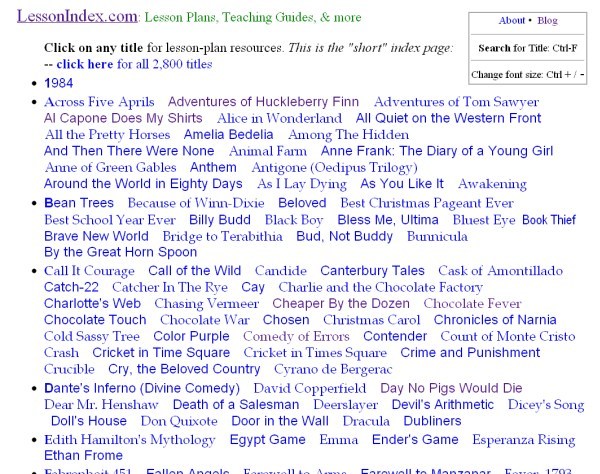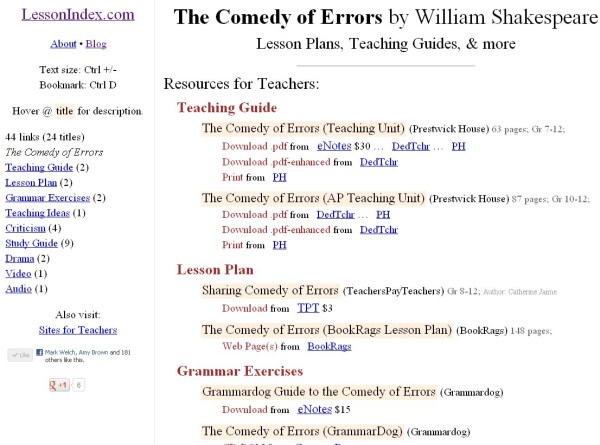Web Site Design and LessonIndex.com: What Do You Think?
Over the past few months, in private emails, some smart folks have criticized the design of my LessonIndex.com web site.
It’s a crude, simple layout. Some call it unprofessional, while others suggest that it’s a poor demonstration of my skills. Some of these comments come from people I know and respect, but …
I think they’re wrong.
Web site design should always start with a clear definition of the intended audience and purpose.
- Audience: K-12 classroom English teachers in public schools (but also some private-school teachers and home-school parents).
- Purpose: quickly find relevant and useful lesson-plan resources, for a specific work of literature (usually a novel or memoir).
LessonIndex.com has a very simple layout. The main index page is an alphabetical list of about 300 literature titles:

Each title is a text link to an individual directory page. There is no search box, because teachers can use Ctrl-F to search the page. The entire list of 300 titles is on a single page. (There is also a separate “big” index page which lists 2,800 literature titles — each with its own directory page.)
The directory pages use a very ordinary HTML list structure to display a series of categories, under which individual product titles are shown along with links to vendors who offer the product for sale:
The directory pages include a left-margin navigation menu (repeated several times on larger pages) so teachers can jump straight to a category. Again, all resources for a specific literature title are listed on a single directory page.
Yes, there are lots of “tweaks” I could make so the site would look more “professional,” but I can’t think of many that would make the site any more useful. And a more professional design might even cause some teachers to perceive the site as less trustworthy.
I’d love to hear others’ feedback about the LessonIndex.com web site.

When posting a comment, please note that you must complete the “Captcha” form which appears below the “Add Your Reply” button. Also note that all comments are moderated (so they won’t appear until I’ve approved them) to reduce spam.
On Facebook, Rebecca Wright (4th grade teacher) wrote:
> “It is a simple, concise layout. A search box would be nice for those of us that primarily use our phones… But I also understand alphabetical order, so it really isn’t a big deal. Thanks for being another resource I can pull from!” <
For another perspective, try this: “Is Presentation More Important Than Content Itself?” (Jordan Kasteler, SearchEngineLand) at http://searchengineland.com/is-presentation-more-important-than-content-itself-123427
On Facebook, Amy Gosla (third grade teacher) wrote:
> “I think the way you have it organized is just fine. Fancy or decorative doesn’t make something better or more professional. In fact, I just went to the site to look up some of the titles I use with my third graders and found more resources to use. And I just shared your site on my FB page.” <
Today, I confirmed that Google AdWords apparently continues to view all of the content on my LessonIndex.com site as a “site policy violation,” because Google AdWords has branded most of the pages on the site as “affiliate bridge pages.” Their objection, as stated by their staff last year, is that my site — which is useful because it provides a very well-organized directory of links to lesson plan resources — includes many affiliate links.
Over the past year, about 90% of site traffic came from Google organic search (free listings in Google’s search results); these links drop teachers directly onto individual directory pages for specific novels. Google’s organic algorithms recognize that the pages on LessonIndex.com are incredibly relevant and useful.
But Google AdWords won’t let me pay to advertise those same pages through AdWords, because a significant part of the “relevance and usefulness” of the pages comes from the inclusion of relevant affiliate links. (Of course, Google would prefer to incorporate its own affiliate links directly into its search results, but thus far its algorithms can’t produce search results that are even remotely “relevant and useful” when compared to my directory.
Today, I created an AdWords ad campaign promoting a page at LessonIndex.com which contains NO affiliate links, just original content. That landing page already appears first in Google’s organic results for the most relevant keyword-phrase, and on the first page of results for all relevant keyword-phrases.
I launched this campaign as an experiment to evaluate the relative value of adding a paid AdWords link for content which already ranks highly organically (something Google encourages, and which I’ve tested at least once every couple of years since AdWords launched). Since the landing page contains no affiliate links (nor any links to pages which contain affiliate links), the “Affiliate Bridge” policy wasn’t violated.
My new ad was immediately disapproved (probably without human involvement), without any explanation, but with the new designation of “site suspended.” I didn’t receive any email regarding the disapproval.
So my LessonIndex.com web site continues to be “locked out” of the Google AdWords universe.
Instead, Google’s organic algorithms will continue to send me lots of FREE traffic, and I’ll spend my pay-per-click search advertising budget with Microsoft AdCenter.
If someone can explain to me why this makes sense for Google, please do so.